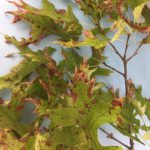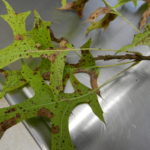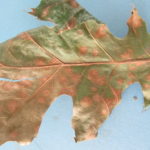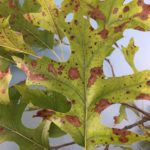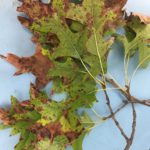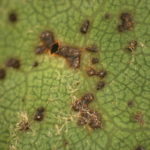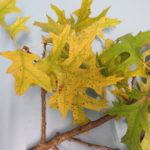Tubakia leaf spot, a fungal disease, infects all species of oak. However, oaks in the red oak group such as black, red and pin oak, appear to be most susceptible. Symptoms on oak include small to large dark brown or reddish-brown spots or blotches. (Figs 1,2,3)
- Figure 1
- Figure 2
- Figure 3
Spotting that occurs on leaf veins may cause large extended areas of dead leaf tissue along the veins (Fig 4). Marginal leaf scorch may also be seen to contain lesions of Tubakia (Fig 5). If trees are heavily infected with Tubakia leaf spot, premature defoliation may occur, however, the disease usually develops so late in the season that overall health of the tree is not affected. Fungicide sprays are not recommended. Cultural practices include maintaining good tree vigor by watering during drought stress periods and fertilizing trees appropriately.
- Figure 4
- Figure 5
A type of anthracnose known as spot anthracnose, may also be present on leaves infected with Tubakia. Spot anthracnose appears as tiny (about 1 mm) black leaf spots (Fig 6) that may be scattered across the leaf but tend to be more numerous near major leaf veins. When several spots occur close together that area of the leaf may die but little overall stress is caused by this minor fungal disease.
Yellowing (chlorosis) of leaf tissue, often accompanied by small, dark brown or reddish-brown, interveinal speckling and spotting (not fungal) is another common symptom on pin oak that accompanies Tubakia.
Yellowing (Fig 7) on pin oak could point to a nutritional problem. In high pH soils iron and manganese are less available for root uptake and may be deficient in the tree while still present in the soil. Nutrient tests of yellow leaves along with soil testing can help determine if this is the case. If you have questions on where to send soil for testing you may contact the PPDL for a compilation of commercial testing labs.
Leaf Diseases BP-143-W
http://www.extension.purdue.edu/extmedia/BP/BP-143-W.pdf
Fertilizing Ornamental Plants HO-140
